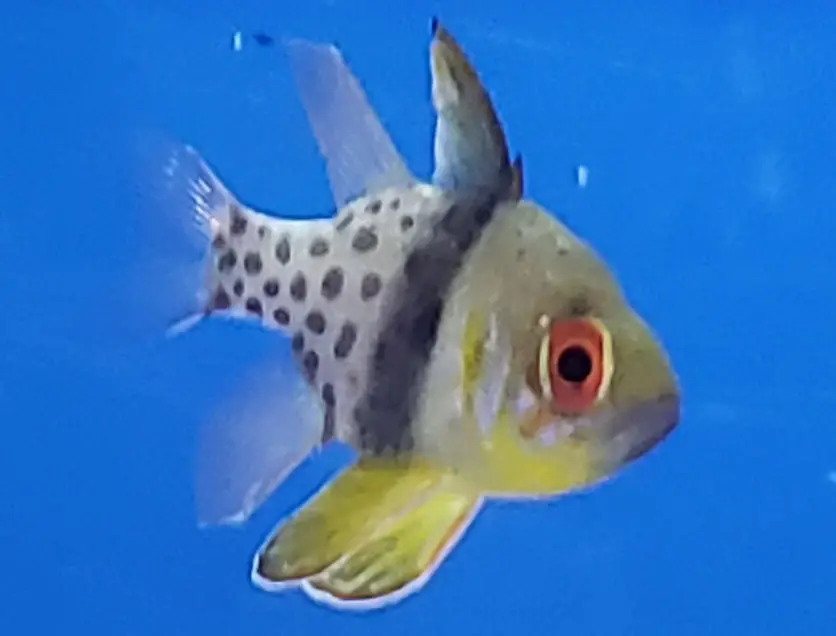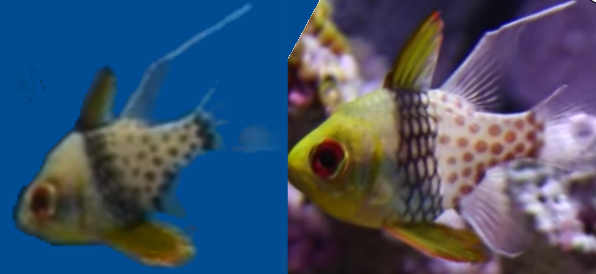Sphaeramia nematoptera
| Difficulty | Easy |
| Minimum Tank Size | 20 Gallons |
| Diet | Carnivore |
| Water Parameters | 72-78 F, pH 8-8.4, Salinity 1.020-1.025 |
| Aggression | Peaceful |
| Size | 3 1/2" |
The Pajama Cardinalfish are found in the western pacific ocean, north of the great barrier reef. They are fairly easy to care for, will not show hostilities in the tank and will spend a lot of their time in the open. Cardinalfish are always interesting to add to a tank, as the float around with rigid bodies rather than swim with a wiggle like most other marine fish.
The Pajama Cardinalfish is a schooling fish, so it is recommended you get at least two of them, if not more. They are fine on their own but they will be far less stressed out when placed in the tank as a group of fish.

Their bodies have a unique coloration to them as their body is comprised of three different sections. They also have bright red eyes making the Pajama Cardinalfish extremely colorful unlike the Banggai Cardinalfish. The pajama’s head is a bright yellow or silver, with black stripe continuing down where dorsal fin is. behind the spotted back end of red brown dots. front and two pectoral fins are vibrant while other mostly clear inconspicuous. so many different colors intensities on its body, no wonder Pajama Cardinalfish is commonly picked for a mid sized marine aquarium.
The basic requirements for the Pajama Cardinalfish are:
- No existing hostile cardinalfish
- Open space in the midsection of the tank
- No predatory fish
You can expect the Pajama Cardinalfish to live up to four years. They are very hardy fish and make for great starter fish in new tanks.
This page will focus on the behavior, feeding and breeding of the Pajama Cardinalfish. If there’s anything I do not cover, feel free to ask in the comment section. I check it regularly and am happy to answer questions.
Behavior & Aggression
Cardinal fish will behave much like Neon Tetras, floating in place or darting around with very little in between. When first introduced to the tank they will likely hide behind anything they can find, but unlike many saltwater fish they are unlikely to stay hidden long and cannot easily hide themselves in rockwork. This means you will likely be able to see the Pajama Cardinalfish swimming around in the tank on their first day.
Cardinalfish, both when alone or when placed in the tank with a school, will often find an open area and make it their home. They will spend most of their time floating around that one spot, making short trips around the tank before returning home. They also enjoy areas under an overhanging rock or corals, but these areas are likely to be taken by other fish if the Pajama Cardinalfish is not introduced before territories are established.
The Pajama Cardinalfish will almost never show any amount of aggression. They may have issues with similar fish, such as other breeds of cardinalfish, however they are the most peaceful of their species. That being said they are much more likely to be bullied rather than bully fish themselves.
Due to their passive nature you should make sure no other fish is harassing the cardinalfish too much. It is expected that other fish may chase them away when either fish is new to the tank, but their should be no long lasting conflict between the pajama and its tank mates. If their are any issues you can try the following to help reduce aggression:
- Rearrange rocks and decorations to reset territories
- Add more rocks to create additional hiding places
- Add more pajama cardinal to create a safe school
Most of these issues are worst case scenarios. In reality the physical aspect of adding multiple Pajama Cardinalfish, meaning acclimating them and moving them intro the tank, should be the hardest part. They should cause no issues and not be harassed by any fish that isn’t already making trouble in the tank.
As with all new fish be sure to have a tight fitting lid. The Pajama Cardinalfish doesn’t jump often but any new fish could be startled and jump to escape even the most harmless of tankmates.
Diet & Feeding
The Pajama Cardinalfish is a carnivore and will accept:
- Prepared foods such as flakes, pellets and mixtures
- Frozen foods, the most common being mysis shrimp, brine shrimp and bloodworms
- live baby brine shrimp/feeder shrimp
As with most fish try to keep a varied diet to ensure the fish stays healthy. Live brine shrimp are a great option, as you can feed the shrimp whatever you would like them to pass onto the fish in your tank. To do this you would need a set up to produce feeding shrimp, but if you are going to have a tank for a long time you may want to look into it.
The pajamas do not have too hard of a time competing for food as they are quick and will be alerted by any member of their school who sees the food. This makes them great for fish who have a hard time noticing when you are feeding the tank.
One of the issues you may run into when feeding is an aggressive competitor. The Pajama Cardinalfish will not fight with other fish to get food. If you notice they are not being allowed to eat try feeding on the opposite sides of the tank at the same time. Once chased away the cardinals will find the second set of food and be free to eat in peace.
Breeding & Sexing
The Pajama Cardinalfish can be bred in the home aquarium and will often do so when given a stable environment with a comfortable amount of food. If you do not want them to breed then you must only select females. The picture below shows a male with an extended second dorsal fin on the left and a female on the right.

The difference in gender is mostly visible in the second dorsal fin. Males will have an extended tip on their secondary dorsal fin while females will just barely extend past the fin. Males will be larger while females are more round, but those two traits are much harder to use as indicators.
They are mouth brooding fish, meaning after breeding the male will carry the eggs in his mouth until they hatch. The male will not eat during this time and the female will protect the male until the fry are hatched.
The fry are not as fragile as most other species and will begin free swimming right away. During this time they may be fed any freshly hatched brine shrimp, copepods or amphipods.